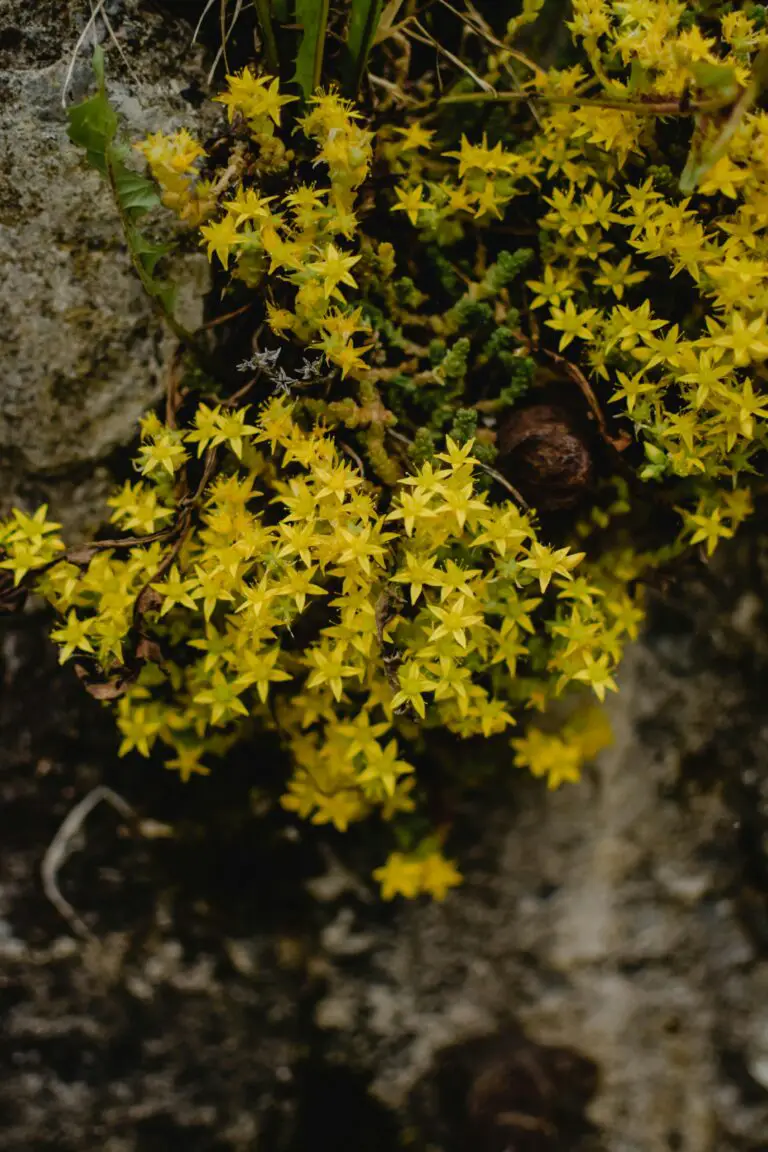Understanding Sedums and Their Growth Habits
Welcome to the enchanting world of sedums, where the robustness of growth meets the beauty of diversity. Sedums, commonly known as stonecrop, are a gardener’s dream, with their hardy nature and distinct forms. But when it comes to their care, a question often arises: should sedums be staked? To unwrap this mystery, let’s dive into the growth habits of these succulent beauties.

Alluring in their variety, sedum species span ground-hugging mats to statuesque clusters teetering upwards. Their charm lies in their adaptability, finding solace in the poorest of soils and flaunting their summer finery with nary a care. But this very carefree spirit can sometimes lead them to overreach, their heavy blossoms nodding to the will of gravity. Imagine a collaboration of lush, leafy greens and star-shaped blooms, all perched precariously on a single stem—one gust away from a humble bow to the earth below.
Take for instance the seductive ‘Autumn Joy’ sedum; with its heady, pink clusters that mature into regal, rust-hued crowns come fall. As the season progresses, you’ll witness a spectacle of pollinators drunk on its nectar-rich offerings. However, for the gardener, this seasonal showboat can become a slight conundrum. Without proper support, their stems may start bending, mimicking the weeping willow rather than the proud stonecrop it’s meant to be. But fear not, proper staking techniques can safeguard your sedums’ posture, ensuring they stand tall and majestic.
If you’re pondering on how to care for these versatile plants, rest assured that their maintenance isn’t a herculean task. A truss here, a support there, and your garden will transform into an open-air theater, showcasing the resilience and splendor of sedums in their prime. So, when it comes to staking, it’s not just about the support—it’s about ensuring these undemanding performers can take a bow at the end of their show, still standing tall and proud.
To Stake or Not to Stake: When Sedums Need Support
So, you’ve got these plump, juicy sedums in your garden that you’re just itching to show off, right? Well, before you go on a staking spree, let’s chat about when your succulent friends actually need a little prop-up. Sedums aren’t high-maintenance rock stars that demand VIP treatment, but sometimes they get a little too wild, and that’s where staking comes into play.
Imagine this: it’s mid-summer, the sun is beaming down, and your sedums are living their best life. But wait, what’s that? A tall, luscious variety of sedum is starting to do the limbo under the weight of its own success—flowers are bursting out, and it just can’t stand up straight anymore. This, my friends, is a prime candidate for a sturdy stake. It’s like giving them a backstage pass to stay in the spotlight without taking a tumble.
And then there are the more ground-hugging types, like the Goldmoss Stonecrop, casually sprawling across your rock garden, not a care in the world. Guess what? They’re totally chill without any staking. They’re the low-key artists of the sedum world, spreading their leafy tunes far and wide without stumbling over themselves.

But here’s the deal: not all sedums are born equal. Some are the sturdy, independent types that scoff at the idea of needing support. Others, well, they’ve got ambitions that can lead them to grow taller and lusher, making them vulnerable to a heavy petal-drop or a harsh rainstorm. For those divas, a discreet stake can keep them belting out blooms all season long without a hiccup.
Need the nitty-gritty on how to tell if your sedum needs a stake? Check out this stellar guide to staking, which will walk you through the whole process. Trust me, a small intervention can prevent your show-stopping sedums from becoming a garden flop.
In essence, to stake or not to stake is all about reading the room—or, in this case, the garden. Keep an eye on your leafy performers and give them a helping hand if they start to droop. With a bit of support, they’ll be the stars of the show, standing tall and proud.
Benefits of Staking Sedum Plants
Picture this: the sun is gleaming, birds are singing, and your garden is an emerald sanctuary, that is until… your cherished sedums start flopping over like weary travellers with oversized baggage. It’s a common sight, isn’t it? But have no fear, staking these succulent beauties might just be the hero’s cape they need. Let’s stake a claim and see why giving your sedums a backrest structures a lot more than just the stems.
Imagine a sedum plant, standing tall and proud, until a stormy gust plays bully and pushes it down to the dirt. It’s heartbreaking, really. But when you introduce a stake into the mix, it’s like handing it a resolute walking stick. With this support, sedums not only stay upright, displaying their vibrant blooms with poise, but they also avoid the dreaded ‘flopping’ that can turn a picture-perfect garden into a wild jumble.
Now, consider the sweltering heat of a midsummer’s day, your sedums desperately trying to breathe. What they need is good air circulation, and staking provides just that. It’s like opening the window on a stuffy afternoon; the plants get freer airflow around their foliage, which in turn, reduces the risk of fungal diseases. So, you’re not just staking; you’re a veritable air traffic controller for your garden’s health.
But perhaps most importantly, a staked sedum is a happy sedum. Think about it: with their stems erect and flowers on full display, they can soak in all that glorious sunshine—photosynthesis at its finest. Plus, they’re not competing with groundcover or being stepped on by oblivious feet. Your staked sedums can smile at the sky without a care in the world—well, except for the odd pesky aphid.
Are you convinced yet? If so, feast your green thumbs on this clever video that unveils the art of staking plants for optimal health and aesthetic. You’ll see real-life examples of staked plants, standing like sentinels in their garden kingdoms, and the robust growth that ensues when plants are given the skeletal support they deserve.
And if you’re seeking more wisdom on nurturing your green friends, cast your gaze over to our treasure trove of Sedum Planting Success: Tips for Vibrant Garden Accents. This is your all-access pass to creating a verdant vista that’s the envy of every plant whisperer in town.
Choosing the Right Stakes and Supports for Sedums
When it comes to keeping your sedums standing tall and proud, selecting the proper stakes and supports is key. Think of stakes as the steadfast friends that keep your plants from drooping after a heavy rainstorm, or the nurturing arms that assist them in reaching for the sun. Sedums, with their succulent leaves and top-heavy blooms, may call for a bit of backup to maintain their picturesque posture. So, how do we ensure our green companions have the sturdy sidekicks they deserve?
First things first: the world of garden supports is as diverse as the sedums themselves! From the unobtrusive and natural bamboo stakes to the more elaborate trellises, there’s an ally for every type of sedum you’re nurturing. Bamboo stakes are the modest ninjas of the plant support realm. They blend seamlessly, never stealing the spotlight from your sedums while providing rock-solid support. For larger, more robust sedums, you might want to buddy up with metal stakes – they’re like the bodybuilders of the support world, ready to handle even the weightiest of succulent clusters without breaking a sweat.
If you’re eyeing a support that’s as decorative as it is functional, obelisks or spiraling supports can add a stroke of architectural flair to your garden tableau. Imagine a ‘Sedum Autumn Joy,’ its heavy clusters of star-shaped flowers spiraling upward, embraced by an elegant metal helix that turns your garden into an art gallery.

The trick to pondering the right partner for your sedums is considering their growth habit and weight. Sedums come in so many shapes and sizes, from sprawling ‘Sedum Sarmentosum’ to statuesque ‘Sedum Spectabile.’ The dainty ‘Sedum reflexum’ might be content with a slim twig, while the hefty ‘Sedum Telephium’ demands the brawn of a wrought-iron pillar to avoid an untimely topple.
Our green-thumbed journey doesn’t end with choosing the right ally; placement is also a pivotal tactical move. Introduce your chosen supports early in the growing season, allowing your sedums to grow intertwined with their companions. This covert operation ensures your plants look like they’re standing unassisted – a natural and unaffected elegance that’s the envy of any gardener.
For those who are eager to transform their green space and debunk the common horticultural myths, consider exploring our insightful article on whether sedums are overtaking your garden space. This resource offers perspective on managing your succulent landscape and ensuring each sedum thrives.
In conclusion, staking your sedums is a blend of art and science. It’s about providing invisible support that lets your plants shine, reading their needs and habits, and being proactive in your gardening approach. With the right stakes and supports in place, your sedums will stand tall, bloom outrageously, and be the robust, eye-catching wonders they’re meant to be – no slouching, no sagging, just pure garden perfection.
How to Properly Stake Your Sedums: A Step-by-Step Guide
When it comes to giving your sedums that extra bit of support, staking is a horticultural move that’s as smooth as velvet yet sturdy as oak! But before we turn you into a staking pro, let’s lay down the lawn-facts: not all sedums need staking. Imagine that! Some sedums stand proud like a sunflower in July, while others might just need a friendly nudge to keep them from flopping over like a puppy that has yet to grow into its paws.
So, for the sedums that do wave the white flag asking for help, here’s the lowdown on how to stake them right. First things first: select stakes that are just the right height—tall enough for your sedums to aspire to but not so tall they lose their plant dignity. Now, gently—and I mean gently, like you’re handling a priceless vase—tie the sedum to the stake. Use soft ties, like an old t-shirt cut into strips or twine designed for the job, and give your plant a nice, comfy hug, not a wrestler’s chokehold.
Step 1: Eye up your sedum’s posture. Is it leaning like the Tower of Pisa? If yes, that’s your stake’s cue!
Step 2: Push the stake into the soil near the sedum’s base. Aim for a balance between firm support and respecting the root zone—no jabbing!
Step 3: Now, embrace your sedum with those ties. Remember, snug, not tight. Think of it as a friendship bracelet, not handcuffs. Make loops that allow for growth, because we’re all about plant empowerment here.
Step 4: As your sedum grows, check on those ties. Loosen them up a bit if they’re getting snug. Show your plants the love they deserve as they reach for the sky!
Step 5: Stone-faced sedum stand-up! Once your leggy sedums are standing tall, admire their newfound stature and the flowers that soar on upright stems!
Now, let’s get visual. I’ve got a gem of a video for you that’s going to show all the good staking stuff in action. It’s like DIY meets gardening, and you’re the star of the show. So grab your popcorn, and let’s roll the tape!
As you follow these steps, keep a watchful eye like a garden ninja. After all, your sedums are on their way to becoming the horticultural sensation of your landscape. They’ll be robust, they’ll be bold, and with your newfound staking savvy, they’ll be standing tall come rain or shine. Stake on, my friends, stake on!
Caring for Staked Sedums: Do’s and Don’ts
So you’ve decided to stake your sedums, and now you’re wondering how to keep them standing tall and proud, right? Staking is just the first step to ensuring your sedums don’t succumb to the flop, especially those with hefty blooms that can weigh them down. The care you provide after staking is crucial for their overall health and aesthetics. Picture this: a lush, upright sedum that’s the envy of the neighborhood—achievable with a few key care practices!
First things first, even a staked sedum requires regular check-ins. You’re the stake-out officer here, making sure the support system remains firm yet not too tight. Remember, plants grow and change with the seasons, and your staked sedum is no exception. An overzealous tie might cut into the stem as it thickens—a definite no-no that can cause more harm than good.
Adjustments are part of the game when you’re nurturing these robust beauties. Think of it like a visit to the tailor for a bespoke suit; your sedums’ stakes need an occasional tweak for that perfect fit. As they grow, gently loosen any bindings and reaffirm the support, guiding them toward the sky. It’s a delicate dance between providing freedom and support, but when done right, it leads to a magnificent display.
And now, for a real-world cautionary tale: There’s a common mistake many gardeners make—they stake, they forget, and then they regret. Ignoring your staked sedums after the initial intervention is like leaving a cake in the oven with no timer. Disaster! Stems can rub against stakes, wind can cause wear, and too-tight ties can choke growth. Stay vigilant, my green-thumbed friends. A simple stroll through your garden to inspect and adjust can prevent these unhappy outcomes.
While we’re talking practical tips, here’s a fantastic resource to add to your gardening toolkit. Take a look at this insightful video for some visual guidance on the care for staked sedums:
Remember, gardening is a hands-on adventure, and your sedums rely on your continued attention after staking. Regular check-ins, adjustments, and a proactive approach will ensure your sedums are neither strangled by neglect nor toppled by their own success. They’ll be the upright, blooming stars of your garden narrative with your help!
Alternatives to Staking: Natural Solutions for Upright Sedums
For those green thumbs questioning whether should sedums be staked, there’s good news! Nature has blessed us with numerous ingenious techniques to keep these succulent beauties standing tall without the need for stakes. Now, let’s swap that stake for some savvy gardening wisdom!
Smart Pruning: Timing is Key
First on our list of natural solutions comes smart pruning. Picture this: It’s early summer, and the sedums are just starting to flesh out. This is your cue to bring out the shears! A mild trim encourages the plants to grow denser and bushier. It’s like giving them a nudge in the right direction – upwards. Remember, it’s all about the timing; cutting them back by a third in late spring can do wonders for their posture.
Strategic Planting: Location, Location, Location
Alternatively, strategic planting can play a crucial role. Imagine you’re plotting a thriller novel, and the sedum is your protagonist. Where you position it in the garden can make all the difference. Choose locations that aren’t too sheltered so your sedums learn to stand up to mild winds, making them naturally sturdier. Plus, making sure they have ample sunlight ensures they aren’t stretching and weakening in search of the sky.
Companion Planting: Strength in Numbers
And then there’s the art of companion planting, a technique as old as gardening itself. Think of it like a buddy system, where plants lean on each other in times of need. By pairing your sedums with taller, stronger plants, you grant them a living trellis. Lavender or small ornamental grasses, for instance, can offer a shoulder to lean on, resulting in an eye-catching tapestry that supports each other in style.
Incorporating these alternative methods to staking not only helps your sedums stay upright but also adds layers of texture and intrigue to your garden’s narrative. But don’t just take my word for it, see for yourself how these strategies can transform your sedum story!
${video_embed(‘https://www.youtube.com/embed/UB7pR_AhX10’)}
Frequently Asked Questions
When it comes to ensuring that your sedum plants thrive with vigor, it’s natural to have a few questions. Let’s dig into some real-life examples and queries that might just mirror your own concerns. Sturdiness, aesthetics, or simply curiosity could bring us to wonder, “should sedums be staked?”
Do Sedum Plants Need Support?
The sight of a sedum tumbling over, its hearty blooms kissing the ground, isn’t uncommon. Take, for example, the ‘Autumn Joy’ variety, which can grow so lush that it seems to sprawl out like a botanical octopus seeking more room to flourish. Some gardeners choose to prop up these larger sedums using stakes, especially if they are planted in overly fertile soil, which encourages leggy growth.

Determining the Need to Stake
One neighbor’s sedum might stand tall while another’s leans lazily. It’s not always a simple verdict. The decision stems from various factors such as the specific sedum species, its location, and the care it’s afforded. A sedum positioned in partial shade, for instance, will reach for sunlight, sometimes to the point of toppling over. It’s these situational nuances that determine whether your green friends will need that extra stake in the ground.
Staking Sedums: A Balancing Act
Imagine a bustling community garden where everyone’s busy with their plots: Tom is all about natural growth, letting his sedums form whimsical shapes, while Sarah values order and uses stakes to ensure her flower beds are neat as a pin. Their approaches highlight the balance gardeners seek between letting plants express their natural habit and maintaining a certain garden aesthetic. Staking should be a thoughtful process, making sure not to harm the plant’s roots or restrict its natural growth impulses.
Best Time to Stake Sedums
Time your staking like you’d time an expertly brewed cup of tea. Starting too early or too late can lead to less than desirable results. If you wait until the sedum is in full bloom, you might not only find it challenging to get the stake in without damage but also miss the chance for the plant to adapt to the support. Conversely, staking too early might restrict growth potential. Generally, the sweet spot is when the sedum reaches about half of its expected height.
Securing Sedums Tastefully
Ever been to a garden where the stakes were more noticeable than the plants themselves? It’s a bit like someone wearing a hat so large it enters the room before they do. Here, subtlety is your ally. Opt for stakes that blend with the foliage or are just barely visible, allowing your sedums to take center stage, supported yet unencumbered, in all their glory.



